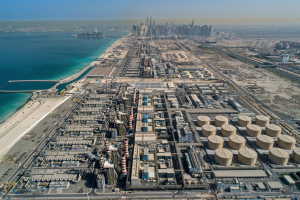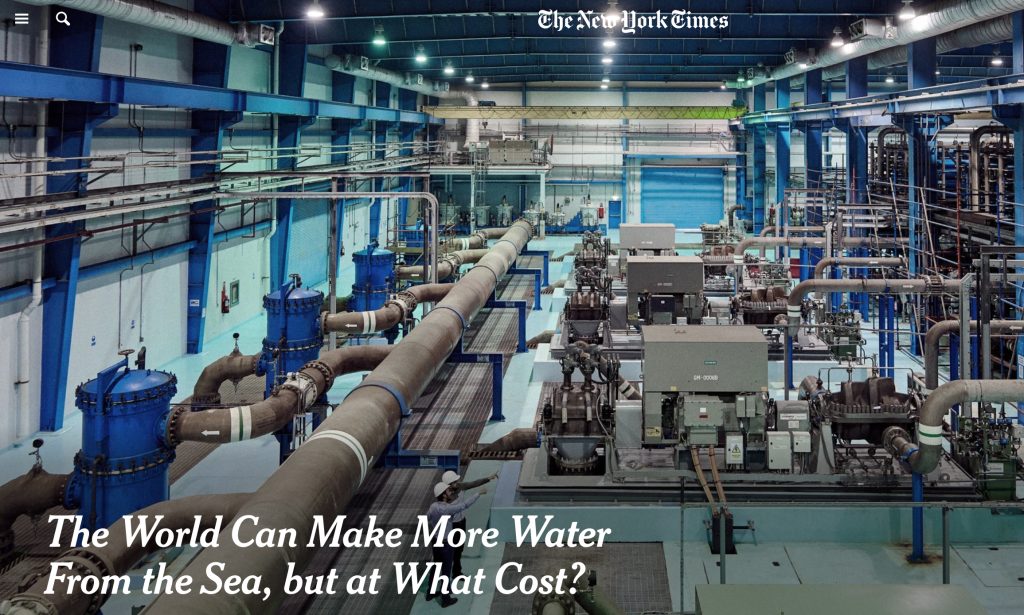UNU-INWEH, Hamilton Canada
World’s ~16,000 desalination plants discharge 142 million cubic meters of brine daily — 50 percent more than previously estimated; Enough in a year to cover Florida under a foot (30.5 cm) of brine
 The fast-rising number of desalination plants worldwide — now almost 16,000, with capacity concentrated in the Middle East and North Africa — quench a growing thirst for freshwater but create a salty dilemma as well: how to deal with all the chemical-laden leftover brine.
The fast-rising number of desalination plants worldwide — now almost 16,000, with capacity concentrated in the Middle East and North Africa — quench a growing thirst for freshwater but create a salty dilemma as well: how to deal with all the chemical-laden leftover brine.
In a UN-backed paper, experts estimate the freshwater output capacity of desalination plants at 95 million cubic meters per day — equal to almost half the average flow over Niagara Falls.
For every litre of freshwater output, however, desalination plants produce on average 1.5 litres of brine (though values vary dramatically, depending on the feedwater salinity and desalination technology used, and local conditions). Globally, plants now discharge 142 million cubic meters of hypersaline brine every day (a 50% increase on previous assessments).
That’s enough in a year (51.8 billion cubic meters) to cover Florida under 30.5 cm (1 foot) of brine.
The authors, from UN University’s Canadian-based Institute for Water, Environment and Health, Wageningen University, The Netherlands, and the Gwangju Institute of Science and Technology, Republic of Korea, analyzed a newly-updated dataset — the most complete ever compiled — to revise the world’s badly outdated statistics on desalination plants.
And they call for improved brine management strategies to meet a fast-growing challenge, noting predictions of a dramatic rise in the number of desalination plants, and hence the volume of brine produced, worldwide.
(Note: The authors use the term “brine” to refer to all concentrate discharged from desalination plants, as the vast majority of concentrate (>95%) originates from seawater and highly brackish groundwater sources.)
The paper found that 55% of global brine is produced in just four countries: Saudi Arabia (22%), UAE (20.2%), Kuwait (6.6%) and Qatar (5.8%). Middle Eastern plants, which largely operate using seawater and thermal desalination technologies, typically produce four times as much brine per cubic meter of clean water as plants where river water membrane processes dominate, such as in the US.
The paper says brine disposal methods are largely dictated by geography but traditionally include direct discharge into oceans, surface water or sewers, deep well injection and brine evaporation ponds.
Desalination plants near the ocean (almost 80% of brine is produced within 10km of a coastline) most often discharge untreated waste brine directly back into the marine environment.
The authors cite major risks to ocean life and marine ecosystems posed by brine greatly raising the salinity of the receiving seawater, and by polluting the oceans with toxic chemicals used as anti-scalants and anti-foulants in the desalination process (copper and chlorine are of major concern).
“Brine underflows deplete dissolved oxygen in the receiving waters,” says lead author Edward Jones, who worked at UNU-INWEH, and is now at Wageningen University, The Netherlands. “High salinity and reduced dissolved oxygen levels can have profound impacts on benthic organisms, which can translate into ecological effects observable throughout the food chain.”
Meanwhile, the paper highlights economic opportunities to use brine in aquaculture, to irrigate salt tolerant species, to generate electricity, and by recovering the salt and metals contained in brine — including magnesium, gypsum, sodium chloride, calcium, potassium, chlorine, bromine and lithium.
With better technology, a large number of metals and salts in desalination plant effluent could be mined. These include sodium, magnesium, calcium, potassium, bromine, boron, strontium, lithium, rubidium and uranium, all used by industry, in products, and in agriculture. The needed technologies are immature, however; recovery of these resources is economically uncompetitive today.
“There is a need to translate such research and convert an environmental problem into an economic opportunity,” says author Dr. Manzoor Qadir, Assistant Director of UNU-INWEH. “This is particularly important in countries producing large volumes of brine with relatively low efficiencies, such as Saudi Arabia, UAE, Kuwait and Qatar.”
“Using saline drainage water offers potential commercial, social and environmental gains. Reject brine has been used for aquaculture, with increases in fish biomass of 300% achieved. It has also been successfully used to cultivate the dietary supplement Spirulina, and to irrigate forage shrubs and crops (although this latter use can cause progressive land salinization).”
“Around 1.5 to 2 billion people currently live in areas of physical water scarcity, where water resources are insufficient to meet water demands, at least during part of the year. Around half a billion people experience water scarcity year round,” says Dr. Vladimir Smakhtin, a co-author of the paper and the Director of UNU-INWEH, whose institute is actively pursuing research related to a variety of unconventional water sources.
“There is an urgent need to make desalination technologies more affordable and extend them to low-income and lower-middle income countries. At the same time, though, we have to address potentially severe downsides of desalination — the harm of brine and chemical pollution to the marine environment and human health.”
“The good news is that efforts have been made in recent years and, with continuing technology refinement and improving economic affordability, we see a positive and promising outlook.”
Background
The growth of desalination
Starting from a few, mostly Middle Eastern facilities in the 1960s, today 15,906 operational desalination plants are found in 177 countries. Two-thirds of such plants are in high-income countries.
The process is becoming more affordable, the paper says, attributable to falling costs due to continued improvements in membrane technologies, energy recovery systems, and the coupling of desalination plants with renewable energy sources.
Brine management can represent up to 33% of a plant’s cost and ranks among the biggest constraints to more widespread development.
Almost half of the global desalination capacity is located in the Middle East and North Africa region (48%), with Saudi Arabia (15.5%), the United Arab Emirates (10.1%) and Kuwait (3.7%) being both the major producers in the region and globally.
East Asia and Pacific and North America regions produce 18.4% and 11.9% of the global desalinated water, primarily due to large capacities in China (7.5%) and the USA (11.2%) respectively.
The widespread use of desalination in Spain (5.7%) accounts for over half of the total desalination in Western Europe (9.2%). The global share in desalination capacity is lower for Southern Asia (3.1%), Eastern Europe and Central Asia (2.4%) and Sub-Saharan Africa (1.9%), where desalination is primarily restricted to small facilities for private and industrial applications.
Desalination is an essential technology in the Middle East and for small island nations which typically lack renewable water resources.
Eight countries — the Maldives, Singapore, Qatar, Malta, Antigua and Barbuda, Kuwait, The Bahamas and Bahrain – can meet all of their water needs through desalination. Six others can meet over 50% of their water withdrawals through desalination: Equatorial Guinea, UAE, Seychelles, Cape Verde, Oman and Barbados.
Almost 22 million m3/day of brine is produced at a distance of greater than 50km from the nearest coastline. Despite the large volume of brine produced in these areas, very few economically viable and environmentally sound brine management options exist. Brine produced inland poses an important problem for many countries located in all world regions, with 64 countries producing more than 10,000 m3/day of brine in inland locations.
Inland brine production is a particular issue in China (3.82 million m3/day), USA (2.42 million m3/day) and Spain (1.01 million m3/day).
###
Authors
Edward Jones1,2, Manzoor Qadir1, Michelle T.H. van Vliet2, Vladimir Smakhtin1, Seong-mu Kang1,3
1 UN University Institute for Water, Environment and Health (UNU-INWEH), Canada
2 Water Systems and Global Change, Wageningen University, The Netherlands
3 Gwangju Institute of Science and Technology (GIST), Republic of Korea
UNU-INWEH
The UNU Institute for Water, Environment and Health is a member of the United Nations University family of organizations. It is the UN Think Tank on Water created by the UNU Governing Council in 1996. Its mission is to help resolve pressing water challenges of concern to the UN, its Member States and their people, through knowledge- based synthesis of existing bodies of scientific discovery; cutting edge targeted research that identifies emerging policy issues; application of on-the-ground scalable solutions based on credible research; and relevant and targeted public outreach.
UNU-INWEH is hosted by the Government of Canada and McMaster University.
* * * * *
Coverage summary presentation, click here
.
.
.
* * * * *
Newswires
The Associated Press, US (via the Daily Mail, UK), Too Much Brine? Study Highlights Growing Toxic Brine Problem, click here
Reuters, UK, Too much salt: water desalination plants harm environment – UN, click here
Spanish, Alrededor de 16.000 plantas desalinizadoras están dañando el medio ambiente según ONU, click here
Portuguese: Sal em excesso: unidades de dessalinização de água prejudicam o meio ambiente, diz ONU, click here
Arabic: الأمم المتحدة: محطات تحلية المياه تضر بالبيئة بسبب المخلفات شديدة الملوحة , click here
Agence France Presse, France, Desalination produces more toxic waste than clean water, click here
French: A la sortie des usines de désalinisation, plus de rejets toxiques que d’eau, click here
Japanese: 海水淡水化、真水上回る量の有毒物質発生 「酸欠海域」形成の恐れも, click here
Chinese: 海水淡化產生有毒物 研究:遠多於提煉淡水, click here
2nd story: Fixing the environment: when solutions become problems, click here
French: Restaurer l’environnement: quand les solutions deviennent problèmes, click here
EFE, Spain, Spanish: Estudio advierte sobre la amenaza medioambiental de plantas desalinizadoras, click here
Portuguese: Estudo adverte para ameaça ambiental de usinas de dessalinização de água, click here
Bloomberg, USA
Saudi Arabia’s thirst for water is creating a toxic brine problem, click here
Spanish: Apaciguar la sed en Arabia Saudita tiene un costo demasiado alto, click here
Portuguese: Água dessalinizada agrava poluição no Oriente Médio e África, click here
Deutsche Presse Agentur, Germany, (via Die Welt) UN warnt vor giftigen Rückständen bei Meerwasserentsalzung, click here
Australian Associated Press, Australia, The world’s growing toxic brine problem, click here
IndoAsian News Service, India, Desalination plants creating salty dilemma, globally: UN, click here
SciDev, UK, Leftover brine threatens future desalination, click here
InterPress Service, Italy: A Salty Dilemma, click here;
op-ed: Quenching Humanity’s Freshwater Thirst Creates a Salty Threat, click here
http://www.ipsnews.net/2019/01/quenching-humanitys-freshwater-thirst-creates-salty-threat/
News sites
UK
BBC Online, UK, Concerns over increase in toxic brine from desalination plants, click here
BBC World Service Radio, UK “A UN-backed paper has warned about the impact on marine life of pumping into the sea a chemical-laden brine which is a by-product from desalination plants that make salty seawater drinkable. Manzoor Qadir is one of the paper’s authors, and explains its findings.” (3 mins, 20 sec long, begins at 15 min, 22 sec) click here
 New York Times (Oct. 22, 2019) The World Can Make More Water From the Sea, but at What Cost?, click here
New York Times (Oct. 22, 2019) The World Can Make More Water From the Sea, but at What Cost?, click here
National Geographic, Desalination plants produce more waste brine than thought, click here
Italian: I desalinatori producono più salamoia di quanto si pensava, click here
Gizmodo, The Dirty Truth About Turning Seawater Into Drinking Water, click here
Wired, Desalination Is Booming. But What About All That Toxic Brine?, click here
Science News, Desalination pours more toxic brine into the ocean than previously thought, click here
Inside Science, Making Salty Water Drinkable Also Makes Brine, click here
France
Le Monde: Dessalement de l’eau : l’ONU alerte sur les quantités de saumure déversées, click here
Le Figaro: La dessalinisation de l’eau de mer crée trop de pollution, click here
Science et Avenir: A la sortie des usines de désalinisation, plus de rejets toxiques que d’eau, click here
Orange actu, A la sortie des usines de désalinisation, plus de rejets toxiques que d’eau, click here
Journal de l’environnement, Les usines de désalinisation polluent plus que prévu click here
Spain
El País, Las desaladoras generan tanta salmuera como para cubrir España, click here
ABC: Las desalinadoras expulsan al mar el doble de salmuera del que se creía, click here
Germany / Austria
Deutschlandfunk,, Sole-Rückstände viel größer als gedacht, click here
WirtschaftsWoche Online, UN warnt: Giftigen Rückständen bei Meerwasserentsalzung, click here
Science.ORF, Entsalzungsanlagen erzeugen Umweltgifte, click here
Belgium
VRT News, VN-rapport: steeds meer pekel in zee door ontziltingsinstallaties, click here
Grenzecho, UN warnt vor giftigen Rückständen bei Meerwasserentsalzung, click here
* * * *
Haaretz, Israel, World Desalination Industry Is Dumping 50% More Toxic Brine Than Thought, click here
Engineering News, South Africa, UN warns of rising levels of toxic brine as more desalination plants are built, click here
Coverage summary, click here
